Since the publication of the NACTO Urban Bikeway Design Guide, NACTO has released additional guidance on facility selection where goals include high-comfort or all-ages bicycling.
See this new resource >
Description
Two-way cycle tracks (also known as protected bike lanes, separated bikeways, and on-street bike paths) are physically separated cycle tracks that allow bicycle movement in both directions on one side of the road. Two-way cycle tracks share some of the same design characteristics as one-way tracks, but may require additional considerations at driveway and side-street crossings.
A two-way cycle track may be configured as a protected cycle track—at street level with a parking lane or other barrier between the cycle track and the motor vehicle travel lane—and/or as a raised cycle track to provide vertical separation from the adjacent motor vehicle lane.
Click on the images below to view 3D concepts of two-way cycle tracks. The configurations shown are based on Cambridge, MA and Washington DC, examples.
Treatment details can be accessed below under design guidance.
Two-Way Cycle Track Benefits
- Dedicates and protects space for bicyclists by improving perceived comfort and safety. Eliminates risk and fear of collisions with over-taking vehicles. Read More+
“Cyclists overwhelmingly feel that riding on 15th Street with the cycle track is much safer and easier now, that it is a useful connection, and that they would go out of their way to ride on the cycle track as opposed to other streets.”
District Department of Transportation. (2012). Bicycle Facility Evaluation.
“Compared with bicycling on a reference street…these cycle tracks had a 28% lower injury rate.”
Lusk, A., Furth, P., Morency, P., Miranda-Moreno, L., Willett, W., Dennerlein, J. (2010). Risk of injury for bicycling on cycle tracks versus in the street. Injury Prevention.
“Cyclists feel most secure on roads with cycle tracks and most at risk on roads with mixed traffic.”
Jensen, S. U., Rosenkilde, C., and Jensen, N. (2007). Road safety and perceived risk of cycle facilities in Copenhagen. Copenhagen: Trafitec Research Center.
- Reduces risk of ‘dooring’ compared to a bike lane, and eliminates the risk of a doored bicyclist being run over by a motor vehicle.
- On one-way streets, reduces out of direction travel by providing contra-flow movement.
- Low implementation cost when making use of existing pavement and drainage and using parking lane or other barrier for protection from traffic.
- More attractive to a wide range of bicyclists at all levels and ages. Read More+
“The data indicate that more bicyclists began using 15th Street after the one-way cycle track was installed and, in general, even more began traveling along the corridor after the two-way cycle track was installed.
After the two-way cycle track was installed, there was a 205 percent increase in bicycle volumes (from before conditions).”
District Department of Transportation. (2012). Bicycle Facility Evaluation.
“Compared with bicycling on a reference street…these cycle tracks had a 28% lower injury rate.”
“Overall, 2.5 times as many cyclists used the cycle tracks compared with the reference streets.”
Lusk, A., Furth, P., Morency, P., Miranda-Moreno, L., Willett, W., Dennerlein, J. (2010). Risk of injury for bicycling on cycle tracks versus in the street. Injury Prevention.
Typical Applications
- On streets with few conflicts such as driveways or cross-streets on one side of the street.
- On streets where there is not enough room for a one-way cycle track on both sides of the street.
- On one-way streets where contra-flow bicycle travel is desired.
- On streets where more destinations are on one side thereby reducing the need to cross the street.
- On streets with extra right-of-way on one side.
- To connect with another bicycle facility, such as a second cycle track on one side of the street.
- Along streets on which bike lanes would cause many bicyclists to feel stress because of factors such as multiple lanes, high traffic volumes, high speed traffic, high incidence of double parking, and high parking turnover.
- On streets for which conflicts at intersections can be effectively mitigated using parking lane setbacks, bicycle markings through the intersection, and other signalized intersection treatments.
- Along streets with high bicycle volumes.
- Along streets with high motor vehicle volumes and/or speeds.
- Special consideration should be given at transit stops to manage bicycle and pedestrian interactions.
Design Guidance
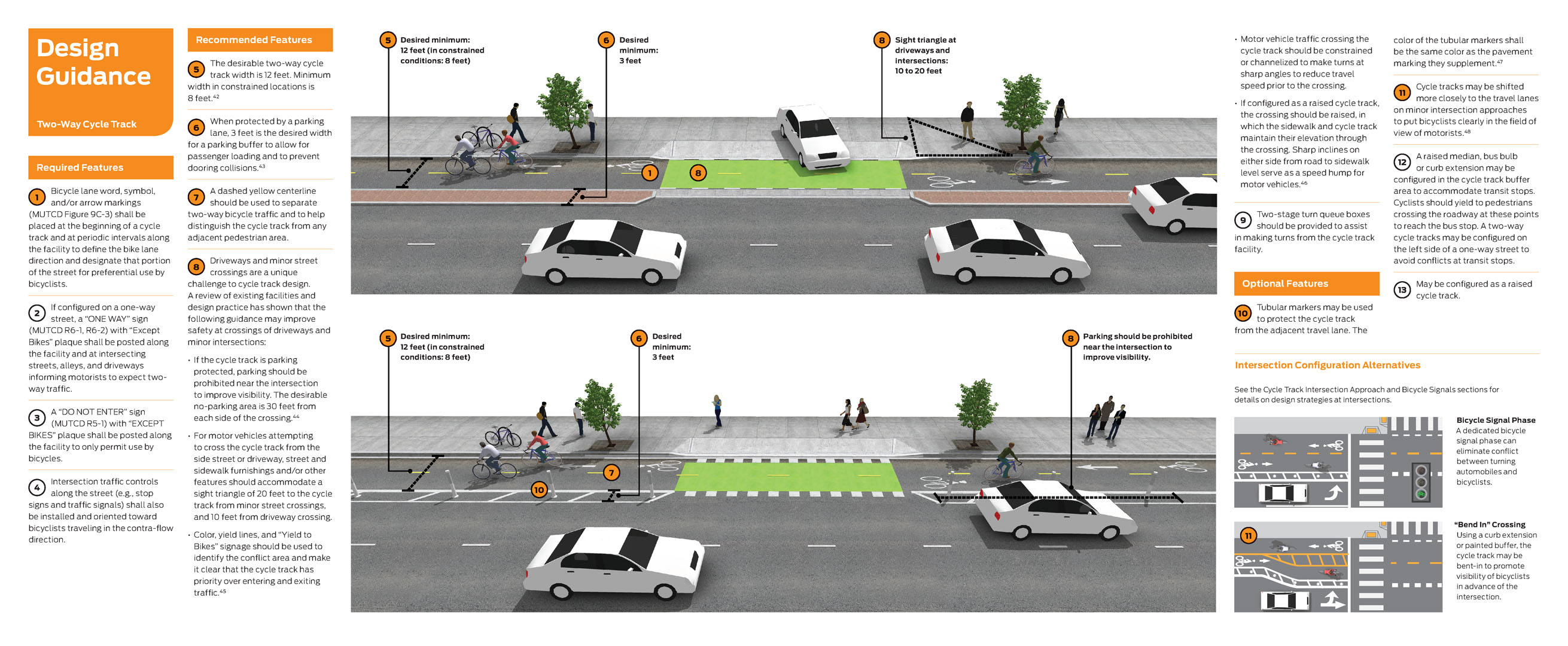
See protected cycle tracks and raised cycle tracks for additional guidance on configuration options. See cycle track intersection approach and bicycle signals for details on design strategies at intersections.
| Required Features |
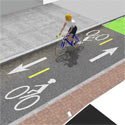 |
Bicycle lane word, symbol, and/or arrow markings (MUTCD Figure 9C-3) shall be placed at the beginning of a cycle track and at periodic intervals along the facility to define the bike lane direction and designate that portion of the street for preferential use by bicyclists. |
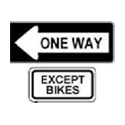 |
If configured on a one-way street, a “ONE WAY” sign (MUTCD R6-1, R6-2) with “EXCEPT BIKES” plaque shall be posted along the facility and at intersecting streets, alleys, and driveways informing motorists to expect two-way traffic. |
 |
A “DO NOT ENTER” sign (MUTCD R5-1) with “EXCEPT BIKES” plaque shall be posted along the facility to only permit use by bicycles. |
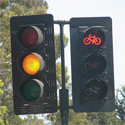 |
Intersection traffic controls along the street (e.g., stop signs and traffic signals) shall also be installed and oriented toward bicyclists traveling in the contra-flow direction. |
| Recommended Features |
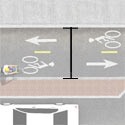 |
The desirable two-way cycle track width is 12 feet. Minimum width in constrained locations is 8 feet. Read More+
Cycle Track Width Guidelines in the Netherlands
 CROW. (2006). Record 25: Design Manual for Bicycle Traffic. CROW, The Netherlands. CROW. (2006). Record 25: Design Manual for Bicycle Traffic. CROW, The Netherlands.
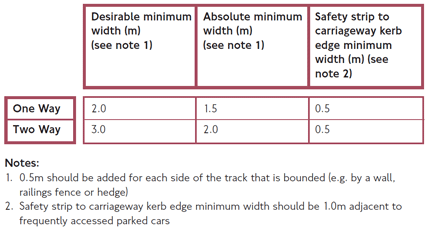 Transport for London. (2005). London Cycling Design Standards.
Transport for London. (2005). London Cycling Design Standards.
|
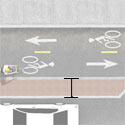 |
When protected by a parking lane, 3 feet is the desired width for a parking buffer to allow for passenger loading and to prevent dooring collisions.
Read More+
“Safety strip to carriageway kerb edge minimum width should be 1.0m adjacent to frequently accessed parked cars.”
Transport for London. (2005). London Cycling Design Standards.
|
 |
In the absence of a raised median or curb, the desired with of the painted buffer is 3 ft. The buffer space should be used to locate bollards, planters, signs or other forms of physical protection.
Read More+

Transport for London. (2005). London Cycling Design Standards.
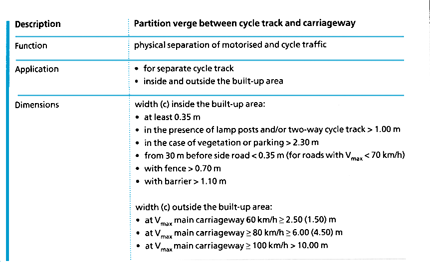
CROW. (2007). Design Manual for Bicycle Traffic. 177.
|
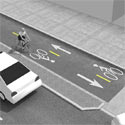 |
A dashed yellow line should be used to separate two-way bicycle traffic and to help distinguish the cycle track from any adjacent pedestrian area. |
 |
Driveways and minor street crossings are a unique challenge to cycle track design. A review of existing facilities and design practice has shown that the following guidance may improve safety at crossings of driveways and minor intersections:
-
- If the cycle track is parking protected, parking should be prohibited near the intersection to improve visibility. The desirable no-parking area is 30 feet from each side of the crossing. Read More+
“Parking must be banned along the street with the bike path for a distance long enough to ensure adequate stopping sign distances for motorists crossing the path.”
Velo Quebec. (2003). Technical handbook of bikeway design. 2nd ed. Quebec: Ministere des Transport du Quebec and the Secretariat au Loisir et au Sport.
- For motor vehicles attempting to cross the cycle track from the side street or driveway, street and sidewalk furnishings and/or other features should accommodate a sight triangle of 20 feet to the cycle track from minor street crossings, and 10 feet from driveway crossing.
- Color, yield lines, and “Yield to Bikes” signage should be used to identify the conflict area and make it clear that the cycle track has priority over entering and exiting traffic. Read More+
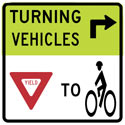 Variant of MUTCD R10-15 to include helmeted bicycle rider symbol (MUTCD figure 9C-3 B).
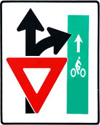 Alternate sign in common use, similar to MUTCD R1-5, 1-5a.
- Motor vehicle traffic crossing the cycle track should be constrained or channelized to make turns at sharp angles to reduce travel speed prior to the crossing.
- If configured as a raised cycle track, the crossing should be raised, in which the sidewalk and cycle track maintain their elevation through the crossing. Sharp inclines on either side from road to sidewalk level serve as a speed hump for motor vehicles. Read More+
“The results show that the paths with raised crossings attracted more than 50 percent more bicyclists and that the safety per bicyclist was improved by approximately 20 percent due to the increase in bicycle flow, and with an additional 10 to 50 percent due to the improved layout.”
Garder, P., Leden, L., Pulkkinen, U. (1998). Measuring the Safety Effect of Raised Bicycle Crossings Using a New Research Methodology. Transportation Research Record, 1636.
Since the publication of the NACTO Urban Bikeway Design Guide, NACTO has released additional intersection design guidance.
See this new resource >
|
 |
Two-stage turn queue boxes should be provided to assist in making turns from the cycle track facility. |
| Optional Features |
 |
Tubular markers may be used to protect the cycle track from the adjacent travel lane. The color of the tubular markers shall be the same color as the pavement marking they supplement. Read More+
“Channelizing devices may also be used along a center line to preclude turns or along lane lines to preclude lane changing, as determined by engineering judgment.
The color of channelizing devices used outside of temporary traffic control zones shall be either orange or the same color as the pavement marking that they supplement, or for which they are substituted.”
FHWA. (2009). Manual on Uniform Traffic Control Devices. 3H.01 Channelizing Devices.
“Tubular markers may be used effectively to divide opposing lanes of road users, divide vehicular traffic lanes when two or more lanes of moving vehicular traffic are kept open in the same direction, and to delineate the edge of a pavement drop off where space limitations do not allow the use of larger devices.”
FHWA. (2009). Manual on Uniform Traffic Control Devices. 3H.01 Channelizing Devices.
|
 |
Cycle tracks may be shifted more closely to the travel lanes on minor intersection approaches to put bicyclists clearly in the field of view of motorists Read More+
“It is recommended that on roads within built-up areas … cycle tracks are bent in 20-30 meters before and intersecting road (bending-in is defined as bending a separate cycle track toward the carriageway, with the distance between the cycle track and the side of the main carriageway measuring between 0 and 2 m).”
“Function of Bending Cycle Track In:
- Improving conspicuity of cyclists
- improving visibility of cyclists
- clarifying right of way situations”
CROW. (2007). Design Manual for Bicycle Traffic.
|
 |
A raised median, bus bulb or curb extension may be configured in the cycle track buffer area to accommodate transit stops. Cyclists should yield to pedestrians crossing the roadway at these points to reach the bus stop.A two-way cycle tracks may be configured on the left side of a one-way street to avoid conflicts at transit stops.
Additional design guidance is provided under Side Boarding Island Stop in the NACTO Transit Street Design Guide. See this guidance > |
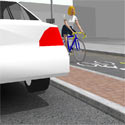 |
May be configured as a raised cycle track. |
ADA/PROWAG Considerations
Two-way cycle tracks have similar ADA/PROWAG considerations as one-way protected cycle tracks and raised cycle tracks depending on the configuration. The wider overall facility width of two-way cycle tracks may simplify accommodating disabled users.
Maintenance
- Two-way cycle tracks should be maintained to be free of pavement damage, broken glass, and other debris.
- Two-way cycle tracks have similar maintenance requirements to one-way protected cycle tracks and raised cycle tracks depending on the configuration.
Treatment Adoption and Professional Consensus
- Commonly used in dozens of European bicycle friendly cities.
- Currently used in the following US cities:
- Austin, TX
- Cambridge, MA
- Eugene, OR
- Indianapolis, IN
- New York City, NY
- Portland, OR
- Saint Petersburg, FL
- Washington, DC